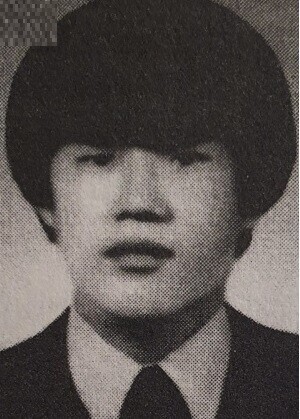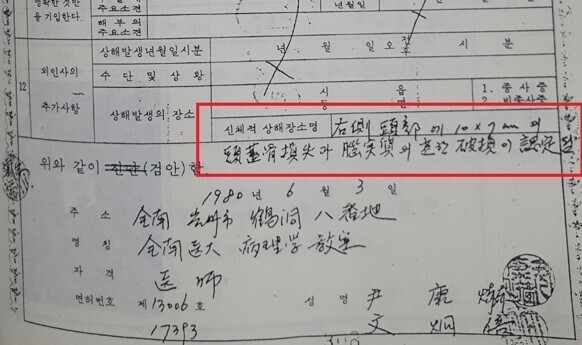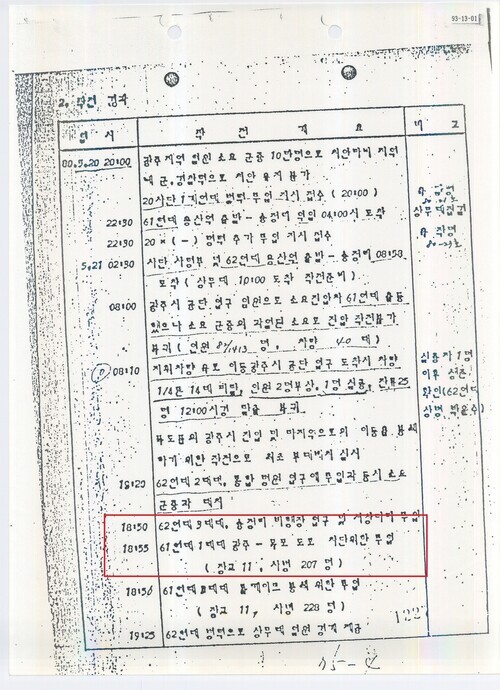hankyoreh
Links to other country sites 다른 나라 사이트 링크
Young man killed during Gwangju Uprising was likely hit by gunfire from helicopter, attests medic

A doctor who examined the bodies of those killed during the May 18 Democratization Movement has raised the possibility that a young man who was killed at the time may have died from machine-gun fire from a military helicopter.
Although bullet marks from shots fired from helicopters during the May 18 movement were previously discovered on Jeonil Building in Gwangju, deaths or injuries caused by them have never been confirmed. Some say the May 18 Democratization Movement Truth Commission should investigate the case.
According to the Hankyoreh’s Monday analysis of the autopsy reports of 165 civilian deaths during the May 18 movement, which the Gwangju High Prosecutors’ Office wrote up on June 3, 1980, one victim among the 135 killed by gunfire lost a significant chunk (10×7cm in size) of the right side of his cranium, the shot severely lacerating his brain. His name was Kim Hyeong-gwan, and he was a 21-year-old reservist at the time.

A bullet had so completely disfigured the face of Kim, who was wearing a camouflage reservist uniform when he died, that Kim’s mother, Ju Eul-seok, walked past Kim’s body at first, not recognizing it and only later accepting that it was her son after seeing the tattoo on his shoulder. Kim’s autopsy report indicates that Kim was transferred to Kwangju Christian Hospital around 4 pm on May 21, 1980, after being shot by an M16 rifle near the railroad in the Baegun neighborhood of Gwangju’s Nam District.
A picture of Kim’s body appears in the book “Documentary Photos of the 1980 People’s Resistance in Gwangju,” published by the Justice and Peace Committee of the Roman Catholic Archdiocese of Gwangju in September of 1987. However, the name of the photo’s subject had not been revealed to the public.
The photo was taken by the late minister Rev. Charles Huntley, who was the head of the chaplain’s office at Kwangju Christian Hospital at the time. Because of the gruesome state of Kim’s body in the photo, the May 18 Democratic Uprising Archives has been storing the original photo separately instead of sharing it with the public.
After seeing the picture of Kim’s body on Wednesday, Dr. Mun Hyeong-bae, who previously worked as a professor at Wonkwang University and was a doctor with the autopsy committee at the time of the uprising, said, “Due to incredible external force, even the brain has been blown away. There’s a good possibility that the death was caused by a gunshot fired from a helicopter.”

The gunshot wound on Kim’s head did not have a distinct entry wound or exit wound. This is because the area where a bullet penetrated Kim’s head was seriously damaged from the impact of the fire.
This is inconsistent with the gunshot wounds on victims shot with M16 rifles, who incurred exit wounds that were larger in size than their entry wounds. For example, according to records, Lee Buk-il, a victim who was born in 1952 and was shot by an M16 whose body Moon examined, had an entry wound 0.5×0.5 cm in size and an exit wound 2×2 cm in size on the upper right part of his head.
Moon continued, “Typically, an M16 gunshot leaves a hole in a victim’s body, but based on the picture of Kim’s body, his entire head has been blown off.” At the time of the pro-democracy struggle, martial law forces were armed with M16s that fired 5.56 mm bullets, while helicopters dispatched to Gwangju were equipped with LMG machine guns that used 7.62 mm bullets.

May 21, the day Kim died, was also the day the late Rev. Cho Pius, the late Lee Gwang-yeong, and former President of the May 18 Bereaved Families Association Jeong Su-man all witnessed the martial law forces shooting at Gwangju civilians from helicopters. On Nov. 30, 2020, judge Kim Jeong-hoon of the 8th criminal division of the Gwangju District Court stated that “it is recognized that there were machine gun shootings via MD 500s [small attack helicopters] on May 21, 1980, and that Rev. Cho Pius witnessed them.”
Moreover, on May 21, when Kim was shot, the martial law army was not yet stationed in the Baegun neighborhood of Gwangju, where Kim incurred his injury. In other words, chances are slim that Kim was shot by a rifle.
The 20th Infantry Division’s detailed report on its reentry operation into Gwangju states that the military was deployed to block the road from Gwangju to Mokpo at 6:55 pm on May 21. Kim was shot in the Baegun neighborhood, where the road from Gwangju to Mokpo begins, nearly three hours earlier.
By Jung Dae-ha, Gwangju correspondent; Kim Yong-hee, Gwangju correspondent
Please direct questions or comments to [english@hani.co.kr]

Editorial・opinion
![[Column] Park Geun-hye déjà vu in Yoon Suk-yeol [Column] Park Geun-hye déjà vu in Yoon Suk-yeol](https://flexible.img.hani.co.kr/flexible/normal/500/300/imgdb/original/2024/0424/651713945113788.jpg) [Column] Park Geun-hye déjà vu in Yoon Suk-yeol
[Column] Park Geun-hye déjà vu in Yoon Suk-yeol![[Editorial] New weight of N. Korea’s nuclear threats makes dialogue all the more urgent [Editorial] New weight of N. Korea’s nuclear threats makes dialogue all the more urgent](https://flexible.img.hani.co.kr/flexible/normal/500/300/imgdb/original/2024/0424/7317139454662664.jpg) [Editorial] New weight of N. Korea’s nuclear threats makes dialogue all the more urgent
[Editorial] New weight of N. Korea’s nuclear threats makes dialogue all the more urgent- [Guest essay] The real reason Korea’s new right wants to dub Rhee a founding father
- [Column] ‘Choson’: Is it time we start referring to N. Korea in its own terms?
- [Editorial] Japan’s rewriting of history with Korea has gone too far
- [Column] The president’s questionable capacity for dialogue
- [Column] Are chaebol firms just pizza pies for families to divvy up as they please?
- [Column] Has Korea, too, crossed the Rubicon on China?
- [Correspondent’s column] In Japan’s alliance with US, echoes of its past alliances with UK
- [Editorial] Does Yoon think the Korean public is wrong?
Most viewed articles
- 1‘We must say no’: Seoul defense chief on Korean, USFK involvement in hypothetical Taiwan crisis
- 2[Reportage] On US campuses, student risk arrest as they call for divestment from Israel
- 3[Column] Park Geun-hye déjà vu in Yoon Suk-yeol
- 4‘Weddingflation’ breaks the bank for Korean couples-to-be
- 5Korea sees more deaths than births for 52nd consecutive month in February
- 6N. Korean delegation’s trip to Iran shows how Pyongyang is leveraging ties with Moscow
- 7Amnesty notes ‘erosion’ of freedom of expression in Korea in annual human rights report
- 8Will NewJeans end up collateral damage in internal feud at K-pop juggernaut Hybe?
- 9N. Korean hackers breached 10 defense contractors in South for months, police say
- 10[Guest essay] The real reason Korea’s new right wants to dub Rhee a founding father